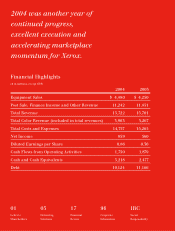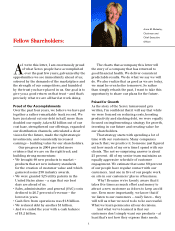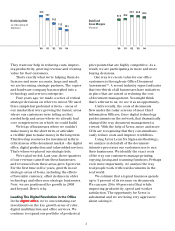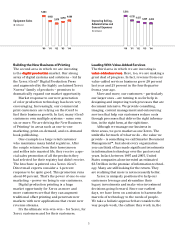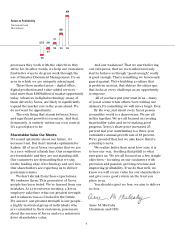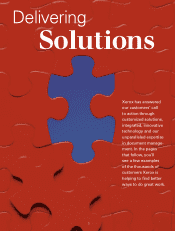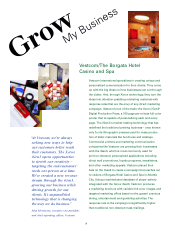Xerox 2004 Annual Report Download - page 4
Download and view the complete annual report
Please find page 4 of the 2004 Xerox annual report below. You can navigate through the pages in the report by either clicking on the pages listed below, or by using the keyword search tool below to find specific information within the annual report.
They want our help in reducing costs,
improving productivity, growing revenue and
creating value for their customers.
That’s exactly what we’re helping them do.
In more and more accounts, large and small,
we are becoming strategic partners. The copier
and hardware company has morphed into a
technology and services enterprise.
Four years ago we made a series of critical
strategic decisions on where to invest. We used
three simple but profound criteria – areas of
our market that were growing the fastest, areas
where our customers were telling us they
needed help and areas where wealready had
core competencies on which we could build.
We let go of businesses where we couldn’t
make money in the short term, or articulate
acredible plan to make money in the long term.
That freed up resources for investment in three
critical areas of the document market – the digital
office, digital production and value-added services.
That’s where we placed our strategic bets.
We’re glad we did. Last year, three-quarters
of our revenue came from these businesses
and revenues from these areas grew 6 percent.
For the first time in five years, growth in our
strategic areas of focus, including the effects
of favorable currency, offset declines in older
technology and other non-strategic businesses.
Now, we are positioned for growth in 2005
and beyond. Here’s why.
Leading The Digital Revolution in the Office
In the digital office,we’re concentrating our
investments on the key growth areas of color,
digital multifunction and office services. We
continue to expand our portfolio of products at
price points that are highly competitive. As a
result, we are participating in more and more
buying decisions.
One way we create value for our office
customers is through our Office Document
AssessmentSM. A recent industry report indicates
that two-thirds of all businesses have initiatives
in place that are aimed at reducing the cost
of document management. You might think
that’s a threat to us; we see it as an opportunity.
Until recently, the costs of documents
flew under the radar screens of most Chief
Information Officers. Once digital technology
put documents on the network, that dramatically
changed the way document management is
viewed. With the help of Xerox, more and more
CIOs are recognizing that they can simultane-
ously reduce costs and improve workflows.
Using XeroxLean Six Sigma methodology,
we analyze in detail all of the document-
intensive processes our customers use to run
their businesses. We identify the exact costs
of the way our customers manage printing,
copying, faxing and scanning functions. Perhaps
even more importantly, we analyze the way
real people work with real documents in the
real world.
We estimate that a typical business spends
up to 5 percent of its revenue on documents.
We can save 20to 40 percent of that while
improving productivity, speed and worker
satisfaction. The opportunity for Xerox is
substantial and weare being very aggressive
about seizing it.
They want our help in reducing costs, improv-
ing productivity, growing revenue and creating
value for their customers.
That’s exactly what we’re helping them do.
In more and more accounts, large and small,
we are becoming strategic partners. The copier
and hardware company has morphed into a
technology and services enterprise.
Four years ago, we made a series of critical
strategic decisions on where to invest. We used
three simple but profound criteria – areas of
our market that were growing the fastest, areas
where our customers were telling us they
needed help and areas where wealready had
core competencies on which we could build.
We let go of businesses where we couldn’t
make money in the short term, or articulate
acredible plan to make money in the long term.
That freed up resources for investment in three
critical areas of the document market – the digital
office, digital production and value-added services.
That’s where we placed our strategic bets.
We’re glad we did. Last year, three-quarters
of our revenue came from these businesses
and revenues from these areas grew 6 percent.
For the first time in five years, growth in our
strategic areas of focus, including the effects
of favorable currency, offset declines in older
technology and other non-strategic businesses.
Now, we are positioned for growth in 2005
and beyond. Here’s why.
Leading The Digital Revolution in the Office
In the digital office,we’re concentrating our
investments on the key growth areas of color,
digital multifunction and office services. We
continue to expand our portfolio of products at
price points that are highly competitive. As a
result, we are participating in more and more
buying decisions.
One way we create value for our office
customers is through our Office Document
AssessmentSM. A recent industry report indicates
that two-thirds of all businesses have initiatives
in place that are aimed at reducing the cost
of document management. You might think
that’s a threat to us; we see it as an opportunity.
Until recently, the costs of documents
flew under the radar screens of most Chief
Information Officers. Once digital technology
put documents on the network, that dramatically
changed the way document management is
viewed. With the help of Xerox, more and more
CIOs are recognizing that they can simultane-
ously reduce costs and improve workflows.
Using XeroxLean Six Sigma methodology,
we analyze in detail all of the document-
intensive processes our customers use to run
their businesses. We identify the exact costs
of the way our customers manage printing,
copying, faxing and scanning functions. Perhaps
even more importantly, we analyze the way
real people work with real documents in the
real world.
We estimate that a typical business spends
up to 5 percent of its revenue on documents.
We can save 20to 40 percent of that while
improving productivity, speed and worker
satisfaction. The opportunity for Xerox is
substantial and weare being very aggressive
about seizing it.
2
’00’02 ’03 ’04’01 ’00’02 ’03 ’04’01
16.7
14.2
11.2 10.1
18.6
Declining Debt
as of December 31
($ billions)
42.4 42.0 40.6
37.4 38.2
Stabilized
Gross Margins
(Percent)


